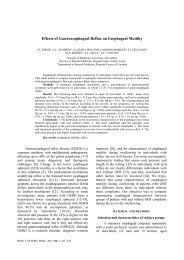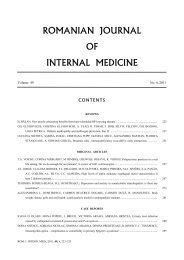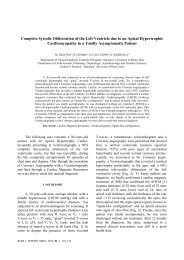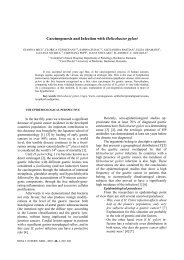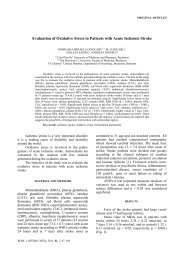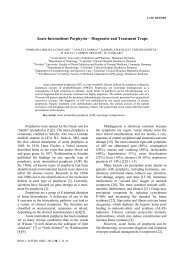Cardiac Involvement in Myasthenia Gravis - Romanian Journal of ...
Cardiac Involvement in Myasthenia Gravis - Romanian Journal of ...
Cardiac Involvement in Myasthenia Gravis - Romanian Journal of ...
You also want an ePaper? Increase the reach of your titles
YUMPU automatically turns print PDFs into web optimized ePapers that Google loves.
7 <strong>Cardiac</strong> <strong>in</strong>volvement <strong>in</strong> myasthenia gravis 185<br />
histological evidence <strong>of</strong> myocarditis versus 0.6%<br />
prevalence <strong>in</strong> unselected autopsy series) [3].<br />
In this case, although a specific moment <strong>of</strong><br />
acute heart failure is miss<strong>in</strong>g, the f<strong>in</strong>al two<br />
diagnostics considered are myocarditis or NSTEMI<br />
with angiographically normal coronary arteries.<br />
The patient was discharged on medical treatment<br />
for myasthenia gravis (neostigm<strong>in</strong>e, corticosteroids)<br />
and ACE <strong>in</strong>hibitors, diuretic and stat<strong>in</strong>. Until this<br />
article was written the thymectomy has not been<br />
performed yet, so we lack histopathological data.<br />
Fig. 8. – Coronary angiography – RAO – no significant<br />
stenosis <strong>of</strong> the left coronary artery.<br />
Fig. 9. – Coronary angiography – LAO – normal right<br />
coronary artery.<br />
Table I<br />
Cardiovascular disorders <strong>in</strong> patients with myasthenia gravis<br />
(after Gugl<strong>in</strong>[3])<br />
Myocarditis<br />
Giant cell myocarditis<br />
Cor pulmonale<br />
Post thymectomy:<br />
Pericarditis<br />
Arrhythmia<br />
Medication related:<br />
Cyclospor<strong>in</strong>e – arterial hypertension<br />
Chol<strong>in</strong>esterase <strong>in</strong>hibitors:<br />
Bradycardia, asystole<br />
Paroxysmal tachycardia<br />
ECG abnormalities:<br />
Nonspecific ST-T changes<br />
Prolonged QT <strong>in</strong>terval<br />
Arrhythmia<br />
Atrial fibrillation/flutter<br />
S<strong>in</strong>us bradycardia<br />
Bundle branch block<br />
Atrioventricular block<br />
Thymoma related<br />
Post-irradiation <strong>in</strong>jury<br />
DISCUSSION<br />
The aforementioned cases have been chosen<br />
<strong>in</strong> order to underl<strong>in</strong>e the peculiarities and polymorphism<br />
<strong>of</strong> heart <strong>in</strong>volvement <strong>in</strong> myasthenia gravis<br />
and the differential problems that they raised.<br />
The first case portraits a typical myasthenia<br />
gravis, with a classical onset with <strong>in</strong>volvement <strong>of</strong><br />
the cephalic muscles with further generalized<br />
<strong>in</strong>volvement. The positive diagnosis was established<br />
based on the cl<strong>in</strong>ical signs and symptoms and<br />
neostigm<strong>in</strong>e test; due to technical problems the<br />
presence <strong>of</strong> antibodies aga<strong>in</strong>st acetylchol<strong>in</strong>e receptors<br />
was not established; this would have been useful<br />
because cl<strong>in</strong>ical trials have found a connection<br />
between the antibody type and cl<strong>in</strong>ical subtype.<br />
As already mentioned, the pathological<br />
mechanism <strong>of</strong> this disease is the decrease <strong>of</strong> the<br />
acetylchol<strong>in</strong>e receptors at the neuromuscular junction<br />
due to an autoimmune answer mediated through<br />
specific antibodies aga<strong>in</strong>st the acetylchol<strong>in</strong>e receptors.<br />
The acetylchol<strong>in</strong>e receptor has five units (2α, 1β, 1δ,<br />
1γ or ε) around a central pore; the α unit conta<strong>in</strong>s<br />
both the acetylchol<strong>in</strong>e b<strong>in</strong>d<strong>in</strong>g site and the primary<br />
immunogenic site). Anti-AchR antibodies are positive<br />
<strong>in</strong> 85% <strong>of</strong> the generalized form myasthenia gravis<br />
and <strong>in</strong> 50% <strong>of</strong> the ocular form; a negative result<br />
does not exclude the diagnosis, because as far as<br />
40% <strong>of</strong> the cases with negative antibodies have<br />
anti-MuSK (specific muscle k<strong>in</strong>ase) receptors,<br />
which play an important role <strong>in</strong> the post-synaptic<br />
differentiation <strong>of</strong> acetylchol<strong>in</strong>e receptors [1]. The<br />
positive antiMuSK antibodies are more frequently<br />
found <strong>in</strong> female patients and the respiratory and<br />
bulbar muscles are frequently <strong>in</strong>volved. Other<br />
types <strong>of</strong> antibodies <strong>in</strong> myasthenia gravis are antismooth<br />
muscle antibodies (84% <strong>of</strong> the patients<br />
younger than 40 years without thymoma or patients<br />
older than 40 years with thymoma) and striational



